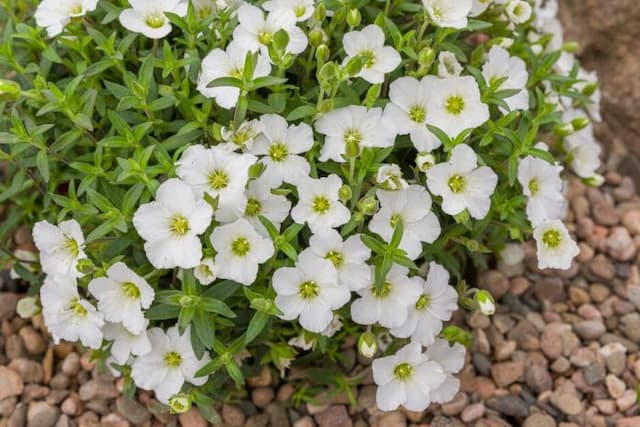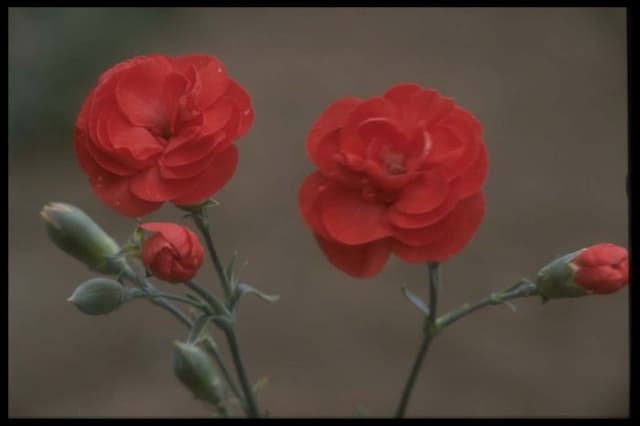Garden Pinks Dianthus 'V.e. Jubilation' (pf)

ABOUT
Dianthus 'V.e. Jubilation' is a vibrant perennial plant that is part of the carnation family. It showcases a profusion of striking flowers that are known for their exquisite beauty and delightful fragrance. The blooms present a distinctive color palette, typically featuring a rich pink hue with subtle variations that can include lighter or darker shades, and sometimes even displaying a charming, contrasting eye at the center of each flower. These blossoms are made up of multiple petals that are often frilled or serrated at the edges, lending a ruffled appearance that enhances their ornamental appeal. The foliage of the Dianthus 'V.e. Jubilation' adds to its allure, with narrow leaves displaying a blue-green or gray-green color that forms a lovely backdrop to the vivid flowers. These leaves can be linear to lanceolate in shape, forming dense tufts or mounds that give the plant a full and lush look. The overall form of the plant is neat and compact, creating an attractive presentation suitable for garden borders, flower beds, and as an accent in rock gardens. Moreover, the blooms of Dianthus 'V.e. Jubilation' often appear atop slender, sturdy stems that rise above the foliage, giving the flowers a floating effect that makes them particularly eye-catching. The fragrant nature of the flowers adds a sensory dimension to the plant, making it a popular choice for gardens where scent is an important aspect of the design. Overall, Dianthus 'V.e. Jubilation' is a plant that combines visual attractiveness with olfactory pleasure, making it a favorite among gardeners and flower enthusiasts alike.
About this plant
 Names
NamesSynonyms
Pinks, Carnations, Sweet William
Common names
Dianthus 'V.e. Jubilation' (pf)
 Toxicity
ToxicityTo humans
The common name for Dianthus 'V.e. Jubilation' is pinks. Pinks are not generally considered toxic to humans. Therefore, ingesting them typically does not lead to poisoning or severe symptoms. However, sensitive individuals may experience mild gastrointestinal discomfort if they consume parts of this plant, though this is not common.
To pets
Pinks are not known to be toxic to pets. Ingesting parts of this plant should not cause serious illness or poisoning in animals such as dogs and cats. As with humans, there might be a rare instance of mild gastrointestinal upset if a pet ingests a significant quantity, but pinks are generally safe around pets.
 Characteristics
CharacteristicsLife cycle
Perennials
Foliage type
Evergreen
Color of leaves
Blue-green
Flower color
Pink
Height
10 inches (25 cm)
Spread
12 inches (30 cm)
Plant type
Herb
Hardiness zones
Varies
Native area
Europe
Benefits
 General Benefits
General Benefits- Aesthetic Appeal: Adds vibrant color and texture to gardens with its pink, red, or white flowers and bushy clumps of grey-green foliage.
- Long Blooming Period: Offers a profusion of flowers from late spring to early fall, providing long-lasting visual interest.
- Attracts Pollinators: Entices bees and butterflies, supporting local ecosystems and pollination.
- Drought Tolerance: Once established, it has good resistance to drought, reducing the need for frequent watering.
- Low Maintenance: Requires minimal care once established, making it suitable for novice gardeners or those with limited time.
- Cold Hardy: Can survive in colder climates, making it versatile for different garden zones.
- Fragrance: Emits a delightful spicy or clove-like fragrance, which can add another layer of enjoyment to your garden.
- Edging and Borders: Ideal for use in borders, edging, or as ground cover due to its compact and tidy growth habit.
- Container Gardening: Suitable for growing in pots or containers where space is limited or soil conditions are poor.
- Rabbit Resistant: Typically not favored by rabbits, which can help prevent damage to the plant in areas with wildlife.
- Cut Flowers: The blooms can be cut and used in floral arrangements, bringing the garden's beauty indoors.
- Evergreen Qualities: In some climates, the foliage remains evergreen throughout the year, offering continuous greenery.
 Medical Properties
Medical PropertiesThis plant is not used for medical purposes.
 Air-purifying Qualities
Air-purifying QualitiesThis plant is not specifically known for air purifying qualities.
 Other Uses
Other Uses- Dye Production: The petals of the Dianthus can be used to create a natural red dye for coloring fabrics and handicrafts.
- Insect Repellent: Some gardeners use Dianthus flowers to deter certain insects due to their strong fragrance, making them a natural pest control in the garden.
- Bookmarks: Dried Dianthus flowers can be laminated or pressed to make decorative bookmarks.
- Culinary Garnish: The vibrant petals can be utilized as an edible garnish for salads and desserts to add color and a mild spicy flavor.
- Art Supplies: The petals can be crushed to make a natural pigment for use in watercolor or other art mediums.
- Floral Baths: Dianthus petals can be added to bathwater for a fragrant and relaxing experience.
- Craft Projects: Dried flowers can be incorporated into paper making, adding texture and color to handmade papers.
- Candle Making: Petals can be used in the process of making candles, either encased in the wax or as a part of the surface decor.
- Potpourri: Dried Dianthus flowers can be included in homemade potpourri mixes to impart their fragrance to your home.
- Decorative Ice Cubes: Freezing Dianthus petals in ice cubes can create unique and colorful accents for drinks at special occasions.
Interesting Facts
 Feng Shui
Feng ShuiThe Carnation is not used in Feng Shui practice.
 Zodiac Sign Compitability
Zodiac Sign CompitabilityThe Carnation is not used in astrology practice.
 Plant Symbolism
Plant Symbolism- Love: Dianthus flowers typically symbolize love and affection, owing to their beautiful blossoms and time-honored presence in romantic bouquets and gardens.
- Admiration: The vibrant colors and attractive patterns of Dianthus are often associated with admiration, making them a popular gift to express this sentiment.
- Pureness: The pure, bright colors of Dianthus can represent purity of emotion, thought, or intent, reinforcing their use in ceremonial and celebratory occasions.
- Boldness: Dianthus, with their striking and contrasting edges (notably in 'V.e. Jubilation'), often evoke a sense of daring or boldness in the language of flowers.
 Water
WaterThe Sweet William ought to be watered deeply, ensuring that the soil is moist but not waterlogged. It's optimal to water this plant once a week, using approximately one gallon of water each time, though this can vary based on weather conditions; more frequent watering may be necessary during particularly hot or dry spells. To avoid potential disease, it's crucial that water is applied directly to the base of the plant, not the foliage. If rainfall is sufficient, additional water might not be necessary, but always check the top inch of soil for dryness to determine if watering is needed.
 Light
LightSweet William thrives best in full sunlight environments, needing at least six hours of direct sunlight each day. For optimal growth and flowering, choose a planting spot that benefits from unfiltered, bright sunlight throughout the day. These plants can tolerate partial shade, but too much shade can affect their bloom and overall health.
 Temperature
TemperatureSweet William prefers temperate conditions and can tolerate a temperature range from about 40 degrees Fahrenheit to around 85 degrees Fahrenheit. However, the ideal temperature for vigorous growth and flowering is between 60 and 70 degrees Fahrenheit. They can endure cooler temperatures but should be protected from harsh frosts.
 Pruning
PruningPruning Sweet Williams is essential for promoting bushier growth and more abundant blooms. Deadheading, or removing spent flowers, will encourage new blooms. Perform thorough pruning in late fall or early spring to remove any dead or weak stems, which helps prevent disease and prepares the plants for new growth. Pruning is typically done annually or after each bloom cycle.
 Cleaning
CleaningAs needed
 Soil
SoilFor Dianthus 'V.e. Jubilation', commonly known as Pinks, the best soil mix is well-draining, enriched with organic matter, and slightly alkaline with a pH of 6.7 to 7.3.
 Repotting
RepottingPinks, should be repotted when they outgrow their current container, which typically occurs every 2 to 3 years.
 Humidity & Misting
Humidity & MistingPinks prefer moderate humidity levels but are quite adaptable. They do not require high humidity environments.
 Suitable locations
Suitable locationsIndoor
Place Pinks in bright light and cool temperatures indoors for best growth.
Outdoor
Plant Pinks in full sun to part shade, in well-drained soil.
Hardiness zone
3-9 USDA.
 Life cycle
Life cycleDianthus 'V.e. Jubilation', commonly known as Pinks or Sweet William, begins its life cycle as a seed, which, once germinated in well-draining soil and with ample sunlight, sprouts into a seedling. The seedling then develops into a vegetative plant, growing leaves and stems, and if the growing conditions are ideal—full sun and cool temperatures—it will soon produce a strong root system. During its flowering stage, which typically occurs in late spring to early summer, the plant displays clusters of fragrant flowers that attract pollinators and are often pink, red, or white in color. After pollination, these flowers develop into seed pods that, when mature, release seeds for the next generation. The plant is often grown as a perennial, meaning it can live for several years, dying back every winter and resuming growth in the spring. Proper care, including deadheading to encourage further blooming and division every few years to maintain vigor, ensures a healthy life cycle and continual growth season after season.
 Propogation
PropogationPropogation time
Spring-early summer
The Dianthus 'V.e. Jubilation', commonly known as the pinks, is best propagated through the division method which is most popular and effective for this perennial plant. The ideal time for its propagation is in the spring or fall when the plant is not in its peak blooming stage. To propagate by division, carefully dig up the entire clump of the plant making sure to keep a substantial amount of the root system intact with each section. Each section should have several healthy shoots and a portion of the root system. These divisions can then be replanted in well-draining soil, at the same depth they were previously growing, and watered thoroughly. With proper care, these divisions will establish themselves and grow into new, healthy plants, thus successfully increasing your stock of Dianthus 'V.e. Jubilation'.


![Pink [Tequila Sunrise]](/_next/image?url=https%3A%2F%2Fplants-admin.emdemapps.com%2Fimages%2Fplants%2F%2Fimages%2F604b5d995d06e.png&w=640&q=75)






